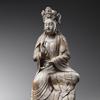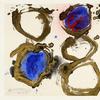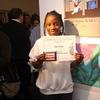MFAH's ICAA Announces Digital Archive for Latin American and Latino Art
- HOUSTON, Texas
- /
- April 07, 2020
Landmark ICAA website and database now offer free global access to primary materials that are critical to academic research in art from Central and South America, the Caribbean, and U.S. Latino communities, at icaa.mfah.org
The Museum of Fine Arts, Houston, and its research institute, the International Center for the Arts of the Americas (ICAA), today launched a redesigned and enhanced website and database for the landmark Documents of Latin American and Latino Art Digital Archive Project. First launched in 2012, the ICAA Documents Project, available at icaa.mfah.org, offers access, free of charge, to source materials crucial to the study and understanding of these major fields of 20th-and 21st century art.
The site makes available a wealth of writings by artists, critics, and curators from Mexico, Central and South America, the Caribbean, and the U.S. Latino communities--Chicano/a, Puerto Rican/Nuyorican, Cuban-American, and Dominican among others. ICAA has now brought the Documents Project into a new era through institutional partnerships that are making a wide variety of materials available for the first time, and through features that make the website and database more accessible and user friendly.
Considered the first, and still the only, digital humanities initiative in the fields of Latin American and Latino art, the ICAA’s Documents Project cuts across national and cultural boundaries. Fully bilingual, the digital archive provides English and Spanish-speaking students, scholars, researchers, collectors and art enthusiasts full access to more than 8,200 letters, manifestos, newspaper and journal articles, exhibition reviews, and other key theoretical, critical and art-historical texts.
“It is difficult to overstate the significance of this project to the fields of Latin American and Latino art,” noted Gary Tinterow, director of the Museum of Fine Arts, Houston and Margaret Alkek Williams Chair. “Twenty years ago, then-MFAH director Peter Marzio and Mari Carmen Ramirez recognized that the lack of access to primary sources was a fundamental barrier to understanding entire generations of artists who made important contributions to 20th-and now 21st-century art. By establishing the ICAA in 2001, and embarking on this monumental project, the Museum moved to assure the future of the field for scholars and students, and audiences worldwide.”
Said Mari Carmen Ramirez, founding director of the ICAA and Wortham Curator of Latin American and Latino Art at the MFAH, “Following on a phase of nearly ten years, during which ad-hoc research teams coordinated from Houston by the ICAA operated in more than 16 Latin American and U.S. cities, the ICAA is shifting its focus toward partnerships with artist’s archives and estates, foundations, and select public and private institutions. This new phase of the Documents Project will develop and expand a host of understudied areas of research, including Latin American contemporary artistic production; the work of Latin American and Latina artists; and a significant expansion of represented Latinx artists, both historical and contemporary. The website redesign enhances the database’s accessibility to users worldwide and connection to ICAA partners outside Houston.”
The material brings to life the ferment of international cultures, ideas, and personalities that swept across 20th, and now 21st–century South and Central America, the Spanish-speaking Caribbean, and Latino communities in the United States, establishing the basis for a comparative history of the art of this region. These writings provide invaluable evidence of how artists, writers, and intellectuals sought to define or challenge notions of a national art; how art movements emerged in response to changing local political situations and the encroachment of perceived North American imperial politics and culture; and how Latin American and Latinx artists contributed major theoretical insights to the early stages of global avant-garde movements and initiated novel tendencies. Significant archival documents include:
- The most significant collection of documents related to Brazilian Constructive Art from the archives of São Paulo collector Adolpho Leirner
- The most complete collection of documents related to one of the most significant site-specific works of Venezuelan artist Gego (Gertrude Goldschmidt), her 1969 Gran Reticularea
- Manuscripts, notebooks and diary entries for paradigmatic works by a host of notable artists, including Carlos Mérida, Abraham Palatnik, León Ferrari, Antonio Berni, Carlos Cruz-Diez, Beatriz González and Tucumán Arde
- Correspondence and seminal articles from Latinx artists’ collectives, including La raza, Chicago Artist’s Coalition and MARCH (Movimiento Artístico Chicano)
- Articles and correspondence by Latinx artists Lorenzo Homar, Antonio Martorell, Amalia Mesa-Bains, and Raphael Montañez Ortiz
Since its inception in 2002, the project has pioneered the digitization and annotation of these documents, making them accessible to more than 38,000 registered users and over 2 million one-time global visitors. The redesigned, user-friendly platform more accurately reflects the activities, events, and interdisciplinary programs of the Center and its flagship Documents of Latin American and Latino Art Project. It includes new sections devoted to news and curated content related to archive holdings, research-in-progress, and other archive-driven projects. The ICAA will also be inviting proposals from artists, scholars, and researchers that engage with the role of archives and documents in the field.
Above all, the new Website is intended to enhance overall accessibility and user experience by:
- Facilitating direct, immediate access through Universal Viewer to the more than 8,000 primary sources and critical texts that make up the ICAA Documents Project.
- Encouraging users to browse by “author,” “title,” “date” and “topic”, download, print, save their results in a “my documents” section, and share them with friends and colleagues within the archive and on social-media outlets.
- Allowing the ICAA’s vetted partners and researchers to upload primary source materials directly to the site, thereby significantly expanding the recovery process which is a core function of any digital repository.


_Hiba_Alyawer__Epic_Dream__2022_Acrylic270x400_c.jpg)



__A270x400_c.jpg)

100x100_c.jpg)











![Peter Paul Rubens (Flemish, 1577–1640), After Titian (Tiziano Vecelli) (Italian [Venetian], c. 1488–1576), Rape of Europa, 1628–29. Oil on canvas, 71 7/8 x 79 3/8 in. Peter Paul Rubens (Flemish, 1577–1640), After Titian (Tiziano Vecelli) (Italian [Venetian], c. 1488–1576), Rape of Europa, 1628–29. Oil on canvas, 71 7/8 x 79 3/8 in.](/images/c/e2/2e/Jan20_Rape_of_Europa100x100_c.jpg)


